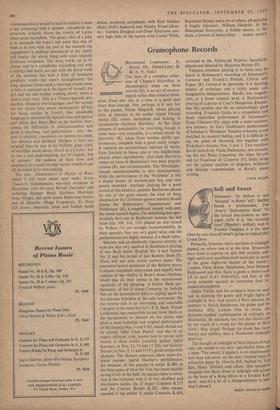Gramophone Records
(RECORDING COMPANIES: D, Decca; OL, Oiseau-Lyre; R, RCA; V, Vox.)
THE issue of a complete collec- tion of Chopin's Mazurkas, in chronological order on three records (D), is an act of musico- logical rather than musical enter- prise. Even one side at a time is a good deal more than enough. Nor, perhaps, is it very fair to the pianist, Nikita Magaloff, whose playing here, in contrast to his earlier mixed Chopin recital (D), seems uninspired and lacking in spontaneous rhythmic flexibility. At the other extreme of unsuitability for recording, though in some ways very enjoyable, is a mixed recital by Horowitz (R), taken from various public per- formances, complete with a good many coughs. It contains an extraordinary mixture of works, from Scarlatti to Sousa, one or two indifferently played, others superlatively. Also from Horowitz comes an issue of Beethoven's two most popular sonatas'(R), not recommended. The 'Moonlight,' though unobjectionable, is also unexceptional, while the performance of the 'Waldstein' is like a steady stream of machine-gun fire, and very poorly recorded. Anybody looking for a good record of this kind (i.e., popular Beethoven played by one of the great names, the kind of thing designed for the Christmas-present market) should plump for Rubinstein's 'Appassionata' and 'Pathetique' (R), a magnificent record, with only the rarest musical lapses. For something less spec- tacularly first-rate in Beethoven sonatas, the last three (op. 109, 110, 111) played on one record by Wiihrer (V) are strongly recommendable. In sheer quantity they are very good value, and the performances are highly musical, if a shade sober.
Sobriety and an absolutely rigorous severity of style are also very marked in Backhaus's playing of two Bach Suites (English No. 6 and French No. 5) and his recital of late Brahms (both D). These will suit only rather austere tastes. The restrained lyrical sentiment of the Brahms pieces is almost completely suppressed, and equally little remains of the vitality of Bach's dance rhythms, which lose all their spring in the monotonous regularity of the phrasing. A livelier Bach per- formance, of the D minor Concerto, by Isabelle Nef on the harpsichord (OL) is slightly spoilt by the extreme faintness of the solo instrument. On the reverse side is an interesting and enjoyable Concerto in the same key by C. P. E. Bach. Wanda Landowska has meanwhile turned from Bach on the harpsichord to Mozart on the piano, and gives a most beautiful and original performance of the Sonatas Nos. 4 and 9 (R), which should not be missed. Only Clara Haskil, and she in an utterly different style, knows how to reveal such beauty in these works. Certainly neither Julius Katchen, in Nos. 11, 13 and 15 (D), nor Guimar Novaes, in Nos. 5, 11 and 15 (V), gives comparable pleasure. The Mozart concertos allow more fre- quent success. Ingrid Haebler's performance; for instance, of the popular A major K.488, in her long series of them for Vox, has many equally strong rivals in the field. Its special claim to atten- tion is the inclusion with it of two excellent and less-known works, the D major Concerto K.175 and the Concert Rondo K.382. Also recom- mended is the earlier A major Concerto K.414, recorded at the Aldeburgh Festival, beautifully played and directed by Benjamin .Britten (D).
Virtuoso romantic playing at its finest may be heard in Rubinstein's recording of Schumann's Carnaval and Franck's Prelude, Choral and Fugue (R). Carnaval in particular is a dazzling display of technique and a richly poetic and imaginative interpretation. Hardly less magnifi- cent, at a lower musical level, is Brailowsky's playing of a group of Liszt's Hungarian Rhapso- dies (R), notable also for an outstandingly good recording. Friedrich Gulda, in a sympathetic and finely controlled performance of Schumann's Piano Concerto (D), plays with a more unobtru- sive mastery. In Gary Graffman's performance of Schubert's 'Wanderer' Fantasy virtuosity is not matched by musical feeling, and it is difficult to see the point of throwing this together with Prokofiev's Sonatas Nos. 2 and 3. Two excellent Ravel records by Vlado Perlemuter, one contain- ing the two Piano Concertos, the other Miroirs and Le Tombeau de Couperin (V), finely bring out the various qualities of elegance, brilliance and delicate impressionism in Ravel's piano writing.
COLIN MASON
































 Previous page
Previous page